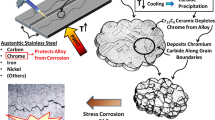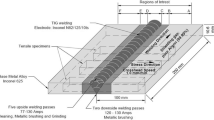Abstract
For medium- and high-carbon stainless steels, welding can induce sensitization in the heat affected zone (HAZ) adjacent to the weld, where chromium carbide \((\hbox {Cr}_{23}\hbox {C}_{6})\) precipitates out of the bulk metal and accumulates at the grain boundaries. This chromium depletion and precipitate accumulation at grain boundaries makes the alloy susceptible to intergranular corrosion, environmentally assisted cracking, and broader fracture. In this paper, we investigate the efficacy of using induction infrared thermography (IIRT) as a non-destructive method for detecting welding-induced sensitization, using the AISI 440C steel as an example. We start by presenting a laboratory experiment to demonstrate this approach, using a radio frequency function generator, an induction wand, and a FLIR SC8203 infrared camera. We use traditional metallography techniques and scanning electron microscopy (SEM) to identify the location of any sensitized regions and characterize the corresponding microstructure. The IIRT experimental results reveal a distinguishable heat signature, with higher temperature observed within the sensitized regions. Next, we present a computational study to simulate the IIRT experiment and investigate the underlying physics. We adopt a three-dimensional thermo-electro-magnetic model including Fourier’s law of heat conduction and Maxwell’s equations for predicting the electromagnetic field caused by a sinusoidal excitation current flowing through the induction coil. We solve the system of governing equations using the commercial solver COMSOL Multiphysics. To numerically investigate the possible causes of the disproportionate heating within the sensitized regions, we realistically vary the values of electrical resistivity and magnetic permeability therein. The simulated results indicate that the heat signature observed in the laboratory experiment may result from the increase of both electrical resistivity and magnetic permeability in the HAZ. The possible physical relationships between sensitization and the variation of these two properties are discussed.










Similar content being viewed by others
Notes
In the 440C steel, the chromium/carbon molar ratio is approximately 22/6, which is very close to that in the \(\hbox {Cr}_{23}\hbox {C}_{6}\) chromium carbide produced in the sensitization process.
References
Jones, D.A.: Principles and Prevention of Corrosion, vol. 2. Prentice Hall, Upper Saddle River ( (1996)
Cormack, E.C: The effect of sensitization on the stress corrosion cracking of aluminum alloy 5456. Technical report, Naval Postgraduate School, Monterey, CA (2012)
Holtz, R.L., Pao, P.S., Bayles, R.A., Longazel, T.M., Goswami, R.: Corrosion-fatigue behavior of aluminum alloy 5083-h131 sensitized at 448 k (175 c). Metall. Mater. Trans. A 43(8), 2839–2849 (2012)
Lv, J., Liang, T., Dong, L., Wang, C.: Influence of sensitization on microstructure and passive property of AISI 2205 duplex stainless steel. Corros. Sci. 104, 144–151 (2016)
Scarberry, R.C., Pearman, S.C., Crum, J.R.: Precipitation reactions in Inconel alloy 600 and their effect on corrosion behavior. Corrosion 32(10), 401–406 (1976)
Was, G.S., Kruger, R.M.: A thermodynamic and kinetic basis for understanding chromium depletion in NI-CR-FE alloys. Acta Metall. 33(5), 841–854 (1985)
Lippold, J.C., Kotecki, D.J.: Welding Metallurgy and Weldability of Stainless Steels. Wiley, New York (2005)
Devine, T.M.: The mechanism of sensitization of austenitic stainless steel. Corros. Sci. 30(2–3), 135–151 (1990)
Tucker, W.C., Lockhart, P., Guzas, E.: Evaluating sensitized chromium steel alloys with induction infrared thermography. J. Nondestr. Eval. 38(2), 42 (2019)
ASTM A262-15: Standard practices for detecting susceptibility to intergranular attack in austenitic stainless steels. Standard, ASTM International, West Conshocken, PA, (2015)
ASTM G67-18: Standard test method for determining the susceptibility to intergranular corrosion of 5XXX series aluminum alloys by mass loss after exposure to nitric acid (NAMLT test). Standard, ASTM International, West Conshocken, PA (2018)
Aquino, J.M., Della Rovere, C.A., Kuri, S.E.: Intergranular corrosion susceptibility in supermartensitic stainless steel weldments. Corros. Sci. 51(10), 2316–2323 (2009)
Garcia, C., De Tiedra, M.P., Blanco, Y., Martin, O., Martin, F.: Intergranular corrosion of welded joints of austenitic stainless steels studied by using an electrochemical minicell. Corros. Sci. 50(8), 2390–2397 (2008)
AISI G108–94, : Standard Test Method for Electrochemical Reactivation (EPR) for Detecting Sensitization of AISI Type 304 and 304L Stainless Steels, p. 2015. Standard, ASTM International, West Conshocken, PA (2015)
Deng, B., Jiang, Y., Juliang, X., Sun, T., Gao, J., Zhang, L., Zhang, W., Li, J.: Application of the modified electrochemical potentiodynamic reactivation method to detect susceptibility to intergranular corrosion of a newly developed lean duplex stainless steel ldx2101. Corros. Sci. 52(3), 969–977 (2010)
Kain, V., Prasad, R.C., De, P.K.: Testing sensitization and predicting susceptibility to intergranular corrosion and intergranular stress corrosion cracking in austenitic stainless steels. Corrosion 58(1), 15–37 (2002)
Shaikh, H., Sivaibharasi, N., Sasi, B., Anita, T., Amirthalingam, R., Rao, B.P.C., Jayakumar, T., Khatak, H.S., Raj, B.: Use of eddy current testing method in detection and evaluation of sensitisation and intergranular corrosion in austenitic stainless steels. Corros. Sci. 48(6), 1462–1482 (2006)
Kikuchi, H., Yanagiwara, H., Takahashi, H., Sumimoto, T., Murakami, T.: Detection of sensitization for 600 alloy and austenitic stainless steel by magnetic field sensor. In: 19th World Conference on Non-Destructive Testing, Munich, Germany (2016)
Abraham, S.T., Albert, S.K., Das, C.R., Parvathavarthini, N., Venkatraman, B., Mini, R.S., Balasubramaniam, K.: Assessment of sensitization in AISI 304 stainless steel by nonlinear ultrasonic method. Acta Metall. Sin. 26(5), 545–552 (2013)
Cobb, A., Macha, E., Bartlett, J., Xia, Y.: Detecting sensitization in aluminum alloys using acoustic resonance and emat ultrasound. In: AIP Conference Proceedings, vol. 1806, p. 050001. AIP Publishing (2017)
Stella, J., Cerezo, J., Rodriguez, E.: Characterization of the sensitization degree in the AISI 304 stainless steel using spectral analysis and conventional ultrasonic techniques. NDT & E Int. 42(4), 267–274 (2009)
Zenzinger, G., Bamberg, J., Satzger, W., Carl, V.: Thermographic crack detection by eddy current excitation. Nondestr. Test. Eval. 22(2–3), 101–111 (2007)
Abidin, I.Z., Tian, G.Y., Wilson, J., Yang, S., Almond, D.: Quantitative evaluation of angular defects by pulsed eddy current thermography. Ndt & E Int. 43(7), 537–546 (2010)
Cheng, L., Tian, G.Y.: Surface crack detection for carbon fiber reinforced plastic (CFRP) materials using pulsed eddy current thermography. IEEE Sens. J. 11(12), 3261–3268 (2011)
Rusli, N.S., Abidin, I.Z., Aziz, S.A.: A review on eddy current thermography technique for non-destructive testing application. Jurnal Teknologi 78(11) (2016)
Oswald-Tranta, B.: Induction thermography for surface crack detection and depth determination. Appl. Sci. 8(2), 257 (2018)
Fisk, M.: Simulation of induction heating in manufacturing. PhD thesis, Luleå tekniska universitet (2008)
He, Y., Yang, R., Xuan, W., Huang, S.: Dynamic scanning electromagnetic infrared thermographic analysis based on blind source separation for industrial metallic damage evaluation. IEEE Trans. Ind. Inf. 14(12), 5610–5619 (2018)
Oswald-Tranta, B.: Thermo-inductive crack detection. Nondestr. Test. Eval. 22(2–3), 137–153 (2007)
COMSOL Inc. COMSOL Multiphysics 5.3a. COMSOL Inc., Stockholm, Sweden (2017)
ASTM E3-11(2017): Standard Guide for Preparation of Metallographic Specimens. Standard, ASTM International, West Conshocken, PA (2017)
ASTM A763-15: Standard Practices for Detecting Susceptibility to Intergranular Attack in Ferritic Stainless Steels. Standard, ASTM International, West Conshocken, PA (2015)
Mukhopadhyay, S.C.: New Developments in Sensing Technology for Structural Health Monitoring. Springer, New York (2011)
Senior, T.B.A.: Impedance boundary conditions for imperfectly conducting surfaces. Appl. Sci. Res. Sect. B 8(1), 418 (1960)
COMSOL Inc. Technical Staff. Ac/dc module 5.3a user’s guide. Technical report, COMSOL Inc. (2017)
Kalkowski, M.K,. Lowe, M.J.S.: On the suitability of different wave description models for ultrasonic characterisation of an austenitic stainless steel weld. Rev. Prog. Quant. Nondestr. Eval. (2019)
Kasap, S.O.: Principles of Electronic Materials and Devices. McGraw-Hill, New York (2006)
L’vov, S.N., Nemchenko, V.F., Kislyi, P.S., Verkhoglyadova, T.S., Ya Kosolapova, T.: The electrical properties of chromium borides, carbides, and nitrides. Soviet Powder Metall. Met. Ceram. 1(4), 243–247 (1962)
Acknowledgements
M.R. and K.W. acknowledge the support of the Office of Naval Research (ONR) through award N00014-18-1-2059. M.R. acknowledges the internship provided by ONR’s Naval Research Enterprise Intern Program (NREIP). E.G. acknowledges the support of the Office of Naval Research (ONR) through the Navy Undersea Research Program (NURP). Wayne Tucker and Patric Lockhart acknowledge the NUWCDIVNPT internal investment programs, as well as ONR’s In-House Independent Laboratory Research (ILIR) and Independent Applied Research (IAR) programs, for funding to support experiments, equipment and materials.
Author information
Authors and Affiliations
Corresponding author
Additional information
Publisher's Note
Springer Nature remains neutral with regard to jurisdictional claims in published maps and institutional affiliations.
Appendix: Additional Details on the Governing Electromagnetic Equation and the Impedance Boundary Condition
Appendix: Additional Details on the Governing Electromagnetic Equation and the Impedance Boundary Condition
One of the primary governing equations comes in the form of the magnetic vector potential formulation of the electromagnetic diffusion equation derived from Maxwell’s equations.
To arrive at this result, the following derivation is undertaken.
From Maxwell’s Law of Induction, the curl of an electric field (\(\mathbf {E}\)) is equal to the negative time derivative of the magnetic field (\(\mathbf {B}\)), i.e.
From Gauss’s Law for Magnetism,
Therefore, the magnetic field \(\mathbf {B}\) can be written in terms of \(\mathbf {A}\), the magnetic vector potential:
Substituting (16) into (14) yields
or equivalently,
Because the curl of a gradient of a vector field is 0, one possible solution to (18) is given by
where \(\varphi \) is the electric scalar potential. This expression can be interpreted as a combination of an induced electric field (\(\mathbf {E}_i\)) and an applied (i.e. source) electric field (\(\mathbf {E}_s\)), i.e.
Multiplying the electric field by the electrical conductivity (\(\sigma \)), the result relates current density (\(\mathbf {J}\)) to the magnetic vector potential (the continuum form of Ohm’s law):
By Ampere’s law,
where \(\mu \) denotes the material’s magnetic permeability, assumed here to be a constant. Combining Eqs. (16), (21), and (22), we obtain
Through a vector identity, (23) can be re-written as
By imposing the Coulomb gauge condition,
we arrive at the final form of the diffusion equation in the time domain,
Assuming \(\mathbf {J}_s\) and \(\mathbf {A}\) are harmonic, the above equation can be moved from the time domain to the frequency domain through a phase transformation, i.e.
Employing (27) into (26), and dropping the subscript “0”, we obtain
The final magnetic vector potential, \(\mathbf {A}\), is found by solving this diffusion equation in the frequency domain. Upon finding the solution for the magnetic vector potential, the eddy currents in the plate are described by
At a surface with impedance \(\eta \), the electric field (\(\mathbf {E}\)) and the magnetic field (\(\mathbf {H}\)) are related through
where \(\mathbf {n}\) denotes the unit surface normal. For example, for a planar surface in the x-y plane, Eq. (30) gives
Again, the electric field \(\mathbf {E}\) can be written as the combination of an induced field and an applied source field, i.e.
Substituting (33) into (30) yields
Applying vector identity
Equation (34) becomes
Therefore, with surface impedance ([35])
we obtain the impedance boundary condition adopted in the COMSOL simulations, i.e.
Rights and permissions
About this article
Cite this article
Roberts, M., Wang, K., Guzas, E. et al. Induction Infrared Thermography for Non-destructive Evaluation of Welding-Induced Sensitization in Stainless Steels. J Nondestruct Eval 40, 19 (2021). https://doi.org/10.1007/s10921-021-00751-3
Received:
Accepted:
Published:
DOI: https://doi.org/10.1007/s10921-021-00751-3




